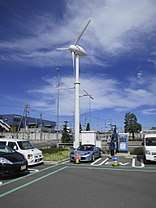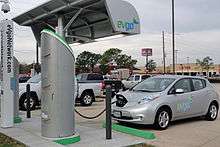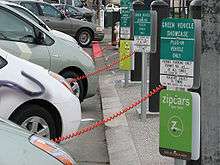Charging station
An electric vehicle charging station, also called EV charging station, electric recharging point, charging point, charge point, electronic charging station (ECS), and electric vehicle supply equipment (EVSE), is an element in an infrastructure that supplies electric energy for the recharging of plug-in electric vehicles—including electric cars, neighborhood electric vehicles and plug-in hybrids.
| ||||
Charging stations for electric vehicles:
|
For charging at home or work, some electric vehicles have converters on board that can plug into a standard electrical outlet or a high-capacity appliance outlet. Others either require or can use a charging station that provides electrical conversion, monitoring, or safety functionality. These stations are also needed when traveling, and many support faster charging at higher voltages and currents than are available from residential EVSEs. Public charging stations are typically on-street facilities provided by electric utility companies or located at retail shopping centers, restaurants and parking places, operated by a range of private companies.
Charging stations provide a range of heavy duty or special connectors that conform to the variety of standards. For common DC rapid charging, multi-standard chargers equipped with two or three of the Combined Charging System (CCS), CHAdeMO, and AC fast charging has become the de facto market standard in many regions.
Charging station types
.jpg)
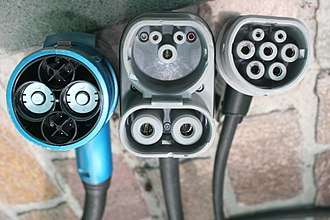
Charging stations fall into four basic categories:
- Residential charging stations: An EV owner plugs into a standard receptacle (such as NEMA connector in the US) when he or she returns home, and the car recharges overnight.[2] A home charging station usually has no user authentication, no separate metering, but may require wiring a dedicated circuit to have faster charging.[3] Some portable chargers can also be wall mounted as charging stations.
- Charging while parked (including public charging stations) – a private or commercial venture for a fee or free, sometimes offered in partnership with the owners of the parking lot. This charging may be slow or high speed and often encourages EV owners to recharge their cars while they take advantage of nearby facilities.[4] It can include parking for an organization's own employees, parking at shopping malls, small centers, and public transit stations.[5][6] Typically, AC Type1 / Type2 plugs are used.
- Fast charging at public charging stations >40 kW, capable of delivering over 60-mile (97 km) of range in 10–30 minutes. These chargers may be at rest stops to allow for longer distance trips. They may also be used regularly by commuters in metropolitan areas, and for charging while parked for shorter or longer periods. Common examples are J1772, Type 2 connector, Combined charging system, CHAdeMO, and Tesla Superchargers.[7]
- Battery swaps or charges in under 15 minutes. A specified target for CARB credits for a zero-emission vehicle is adding 200 miles (approx. 320 km) to its range in under 15 minutes. In 2014, this was not possible for charging electric vehicles, but it is achievable with EV battery swaps. It intends to match the refueling expectations of regular drivers and give crane mobile support for discharged vehicles where there is no charging station.
Battery capacity and the capability of handling faster charging are both increasing, and methods of charging have needed to change and improve. New options have also been introduced (on a small scale, including mobile charging stations and charging via inductive charging mats). The differing needs and solutions of various manufacturers has slowed the emergence of standard charging methods, and in 2015, there is a strong recognition of the need for standardization.
Charging time
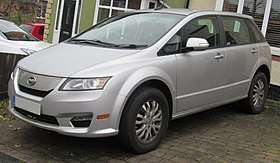
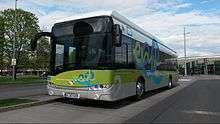
The charging time depends on the battery capacity and the charging power. In simple terms, the time rate of charge depends on the charging level used, and the charging level depends on the voltage handling of the batteries and charger electronics in the car. The U.S.-based SAE International defines Level 1 (household 120V AC) as the slowest, Level 2 (upgraded household 240 VAC) in the middle and Level 3 (super charging, 480V DC or higher) as the fastest. Level 3 charge time can be as fast as 30 minutes for an 80% charge, although there has been serious industry competition about whose standard should be widely adopted. Charge time can be calculated using the formula: Charging Time [h] = Battery Capacity [kWh] / Charging Power [kW][8]
The usable battery capacity of a first-generation electric vehicle, such as the original Nissan Leaf, is about 20 kWh, giving it a range of about 100 mi (160 km). Tesla was the first company to introduce longer range mass production electric vehicles, initially releasing their Model S with battery capacities of 40 kWh, 60 kWh and 85 kWh, with the latter having an estimated range of about 480 km (300 mi). Plug-in hybrid vehicles have capacity of roughly 3 to 20 kWh, for an electrical range of 20 to 80 kilometers (15 to 50 miles), but the gasoline engine ensures the full range of a conventional vehicle.
For normal charging (up to 7.4 kW), car manufacturers have built a battery charger into the car. A charging cable is used to connect it to the electrical network to supply 230 volt AC current. For quicker charging (22 kW, even 43 kW and more), manufacturers have chosen two solutions:
- Use the vehicle's built-in charger, designed to charge from 3 to 43 kW at 230 V single-phase or 400 V three-phase.
- Use an external charger, which converts AC current into DC current and charges the vehicle at 50 kW (e.g. Nissan Leaf) or more (e.g. 120-135 kW Tesla Model S).
| Power supply | Power | Voltage | Max. current | Charging time |
|---|---|---|---|---|
| Single phase | 3.3 kW | 230 V AC | 16 A | 5–6 hours |
| Single phase | 7.4 kW | 230 V AC | 32 A | 2-2½ hours |
| Three phase | 11 kW | 400 V AC | 16 A | 1½-2 hours |
| Three phase | 22 kW | 400 V AC | 32 A | 44–55 minutes |
| Three phase | 43 kW | 400 V AC | 63 A | 22–28 minutes |
| Direct current (DCFC) | 50 kW | 400–500 V DC | 100–125 A | 19–24 minutes |
| Direct current (DCFC) | 120 kW | 300–500 V DC | 300–350 A | 8–10 minutes |
The user finds charging an electric vehicle as simple as connecting a normal electrical appliance; however to ensure that this operation takes place in complete safety, the charging system must perform several safety functions and dialogue with the vehicle during connection and charging.
Costs
In 2017, Tesla gave the owners of its Model S and Model X cars a credit that gives 400 kWh for free at a Supercharger.[9] After that credit is used, drivers using Tesla Superchargers have to pay per kWh. The price ranges from $0.06 to $0.26 per kWh in the United States.[10] Tesla superchargers are only usable by Tesla vehicles.
Other charging networks are available for non-Tesla vehicles. The Blink network of chargers has both Level 2 and DC Fast Chargers and charges separate rates for members and non members. Their prices range from $0.39 to $0.69 per kWh for members and $0.49 to $0.79 per kWh for non members, depending on location.[11] The ChargePoint network has free chargers and paid chargers that drivers activate with a free membership card.[12] The paid charging stations' prices are based on local rates (similarly to Blink). Other networks use similar payment methods as typical gas stations, in which one pays with cash or a credit card per kWh of electricity.
Safety
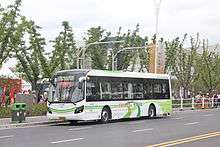
Although the rechargeable electric vehicles and equipment can be recharged from a domestic wall socket, a charging station is usually accessible to multiple electric vehicles and has additional current or connection sensing mechanisms to disconnect the power when the EV is not charging.
There are two main types of safety sensor:
- Current sensors which monitor the power consumed, and maintain the connection only if the demand is within a predetermined range. Sensor wires react more quickly, have fewer parts to fail and are possibly less expensive to design and implement. Current sensors however can use standard connectors and can readily provide an option for suppliers to monitor or charge for the electricity actually consumed.
- Additional physical "sensor wires" which provide a feedback signal such as specified by the undermentioned SAE J1772 and IEC 62196 schemes that require special (multi-pin) power plug fittings.
Until 2013, there was an issue where Blink chargers were overheating and causing damage to both charger and car.[13][14] The solution employed by the company was to reduce the maximum current.[15]
Different Charging Modes
IEC 61851-1 - the International standard for electric vehicle conductive charging system has defined 4 Modes of EV charging.
Mode 1: Domestic socket and extension cord
The vehicle is connected to the power grid through standard socket-outlets present in residences, which depending on the country are usually rated at around 10 A. To use mode 1, the electrical installation must comply with the safety regulations and must have an earthing system, a circuit breaker to protect against overload and an earth leakage protection. The sockets have blanking devices to prevent accidental contacts.
The first limitation is the available power, to avoid risks of:
- Heating of the socket and cables following intensive use for several hours at or near the maximum power (which varies from 8 to 20 A depending on the country).
- Fire or electric injury risks if the electrical installation is obsolete or if certain protective devices are absent.
The second limitation is related to the installation's power management.
- As the charging socket shares a feeder from the switchboard with other sockets (no dedicated circuit) if the sum of consumption exceeds the protection limit (in general 16 A), the circuit-breaker will trip, stopping the charging.
Mode 2: Domestic socket and cable with a protection device
The vehicle is connected to the main power grid via household socket-outlets. Charging is done via a single-phase or three-phase network and installation of an earthing cable. A protection device is built into the cable. This solution is more expensive than Mode 1 due to the specificity of the cable.
Mode 3: Specific socket on a dedicated circuit
The vehicle is connected directly to the electrical network via specific socket and plug and a dedicated circuit. A control and protection function is also installed permanently in the installation. This is the only charging mode that meets the applicable standards regulating electrical installations (IEC 61851). It also allows load shedding so that electrical household appliances can be operated during vehicle charging or on the contrary optimize the electric vehicle charging time.
Mode 4: Direct current (DC) connection for fast recharging
The electric vehicle is connected to the main power grid through an external charger. Control and protection functions and the vehicle charging cable are installed permanently in the installation.
Different Charging Levels
The Society of Automotive Engineering (SAE) defines the general physical, electrical, communication and performance requirements for the EV charging systems used in North America, as part of standard SAE J1772. Below are the different charging levels[16] that are practiced in North American market.
Based on the rated power, voltage and current, the charging levels in North America are classified into three categories:
- Level 1: refers to the charging from the regular household 120 V outlets with a maximum current of 12 or 15 A, which delivers a maximum power of 1.44 kW or 1.92 kW. Here the active charging element is inside the car (EV's on-board charger).
- Level 2: can be from the 240 V outlet or from a dedicated EV charge point (EVSE) ; AC voltage at 240 V with a maximum current of 80 A and a maximum power of 19.2 kW. In level-2 also uses the EV's on-board charger.
- Level 3: Here, the charger is off-board (meaning the EV's on-board charger is by-passed and the charging station provides DC voltage directly to the battery via a DC connector, with a maximum power of 400 kW.
In addition to these standards for electric cars and light trucks, an extension to the CCS DCFC standard is being developed for large commercial vehicles. This is being lead by the CharIN Association which developed CCS. It will be called High Power Charging for Commercial Vehicles (HPCCV). HPCCV is expected to operate in the range of 200-1500 Volts and 0-3000 Amps for a theoretical maximum power of 4.5 MW. The proposal calls for HPCCV charge ports to be compatible with existing CCS and HPC chargers.[17]
Public charging stations
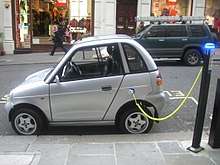
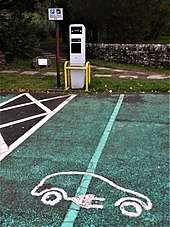
Charging stations for electric vehicles may not need much new infrastructure in developed countries, less than delivering a new alternative fuel over a new network.[18] The stations can leverage the existing ubiquitous electrical grid and home recharging is an option, since most driving is local over short distances which reduces the need for charging mid-trip. For example, in the United States, 78% of commutes are less than 40 miles (64 km) round-trip.[19] Nevertheless, longer drives between cities and towns require a network of public charging stations or another method to extend the range of electric vehicles beyond the normal daily commute. One challenge in such infrastructure is the level of demand: an isolated station along a busy highway may see hundreds of customers per hour if every passing electric vehicle has to stop there to complete the trip. In the first half of the 20th century, internal combustion vehicles faced a similar infrastructure problem.
Currently charging stations are being installed by public authorities, commercial enterprises and some major employers in order to stimulate the market for vehicles that use alternative fuels to gasoline and diesel fuels. For this reason, most charge stations are currently either provided gratis or accessible to members of certain groups without significant charge (e.g. activated by a free "membership card" or by a digital "day code").
As of December 2012, around 50,000 non-residential charging points were deployed in the U.S., Europe, Japan and China.[20] As of August 2014, there are 3,869 CHAdeMO quick chargers deployed around the world, with 1,978 in Japan, 1,181 in Europe and 686 in the United States, 24 in other countries.[21] As of December 2013, Estonia is the first and only country that had completed the deployment of an EV charging network with nationwide coverage, with 165 fast chargers available along highways at a maximum distance of between 40 to 60 km (25 to 37 mi), and a higher density in urban areas.[22][23][24]
As of August 2018, there were 800,000 electric vehicles and 18,000 charging stations in the United States.[25] As of March 2013, 5,678 public charging stations existed across the United States, with 16,256 public charging points, of which 3,990 were located in California, 1,417 in Texas, and 1,141 in Washington.[26][27] As of November 2012, about 15,000 charging stations had been installed in Europe.[28]
As of March 2013, Norway, which has the highest electric ownership per capita, had 4,029 charging points and 127 quick charging stations.[29] As part of its commitment to environmental sustainability, the Dutch government initiated a plan to establish over 200 fast (DC) charging stations across the country by 2015. The rollout will be undertaken by Switzerland-based power and automation company ABB and Dutch startup Fastned, and will aim to provide at least one station every 50 kilometres (31 miles) for the Netherlands' 16 million residents.[30] In addition to that, the E-laad foundation installed about 3000 public (slow) charge points since 2009.[31]
As of December 2012, Japan had 1,381 public quick-charge stations, the largest deployment of fast chargers in the world, but only around 300 slow chargers.[20] As of December 2012, China had around 800 public slow charging points, and no fast charging stations.[20] As of December 2012, the country with the highest ratio of quick chargers to electric vehicles (EVSE/EV) was Japan, with a ratio of 0.030, and the Netherlands had the largest ratio of slow EVSE/EV, with more than 0.50, while the U.S had a slow EVSE/EV ratio of 0.20.[20]
As of September 2013, the largest public charging networks in Australia exist in the capital cities of Perth and Melbourne, with around 30 stations (7 kW AC) established in both cities – smaller networks exist in other capital cities.[32]
In April 2017, YPF, the state-owned oil company of Argentina, reported that it will install 220 fast-load stations for electric vehicles in 110 of its service stations in national territory.[33]
As of August 2019, in the U.S., there are 2,140 CHAdeMO charge stations (3,010 plugs), 1,888 SAE CCS1 charge stations (3,525 plugs), and 678 Tesla super charger stations (6,340 plugs), according to the U.S. DoE's Alternative Fuels Data Center.[34]
Locations
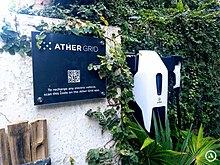
Charging stations can be found and will be needed where there is on-street parking, at taxi stands, in parking lots (at places of employment, hotels, airports, shopping centers, convenience shops, fast food restaurants, coffeehouses etc.), as well as in the workplaces, in driveways and garages at home. Existing filling stations may also incorporate charging stations. The electrical facilities at RV parks are sometimes used for charging - especially in rural areas where normal EV charging facilities are not available. As of 2017, charging stations have been criticized for being inaccessible, hard to find, out of order, and slow; thus reducing EV expansion.[35] At the same time more gas stations add EV charging stations to meet the increasing demand among EV drivers.[36] Worldwide, hotels are adopting a policy of providing their guests with electric car charging. Recent evidence using machine learning and artificial intelligence suggests that U.S. consumers may be equally satisfied with government-run versus privately run charging stations and that urban locations garner higher negative sentiment as compared to non-urban locations.[37]
Vehicle and charging station projects and joint ventures
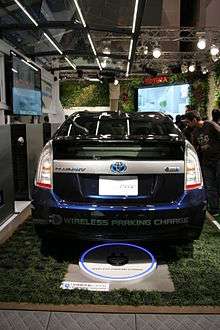

Electric car manufacturers, charging infrastructure providers, and regional governments have entered into many agreements and ventures to promote and provide electric vehicle networks of public charging stations.
The EV Plug Alliance[38] is an association of 21 European manufacturers which proposes an alternative connecting solution. The project is to impose an IEC norm and to adopt a European standard for the connection solution with sockets and plugs for electric vehicle charging infrastructure. Members (Schneider Electric, Legrand, Scame, Nexans, etc.) argue that the system is safer because they use shutters. General consensus is that the IEC 62196 and IEC 61851-1 already have taken care of safety by making parts non-live when touchable.[39][40][41]
Battery swapping
A battery swapping (or switching) station is a place at which a vehicle's discharged battery or battery pack can be immediately swapped for a fully charged one, eliminating the delay involved in waiting for the vehicle's battery to charge. Battery swapping is common in warehouses using electric forklift trucks.[42]
History
The concept of an exchangeable battery service was first proposed as early as 1896, in order to overcome the limited operating range of electric cars and trucks. It was first put into practice between 1910 and 1924, by Hartford Electric Light Company, through the GeVeCo battery service, and was initially available for electric trucks. The vehicle owner purchased the vehicle, without a battery, from General Vehicle Company (GeVeCo), part-owned by General Electric,[43] and the electricity was purchased from Hartford Electric through the use of an exchangeable battery. Both vehicles and batteries were modified to facilitate a fast battery exchange. The owner paid a variable per-mile charge and a monthly service fee to cover maintenance and storage of the truck. During the period of the service, the vehicles covered more than 6 million miles.
Beginning in 1917, a similar successful service was operated in Chicago for owners of Milburn Electric cars, who also could buy the vehicle without the batteries.[44] A rapid battery replacement system was implemented to keep running 50 electric buses at the 2008 Summer Olympics.[45]
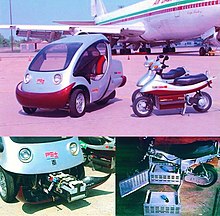
In 1993, Jonathan Tennyson created Suntera, The Solar Electric Chariot Company[46]. With the focus of reintroducing battery-swap stations to the world, Suntera developed a two-seat 3-wheel electric vehicle called the SUNRAY, which came with a battery cartridge that swapped out in minutes at a battery-swap station located along a highway or roadside. In 1995, Jonathan exhibited his SUNRAY and a 2-wheel battery-swap motor scooter designed by TUCKER car designer Budd Steinhilbur [47] at the Geneva Motor Show. After Jonathan Tennyson died from cancer in 1997, his electric car and motor scooter company was renamed Personal Electric Transports[48](P.E.T.). In 2001, P.E.T.’s C.E.O. Anthony Locricchio added Electric Vehicle artist & inventor Todd Bank[49] to the team to prototype Todd’s EV’s and battery-swap stations under pilot-program funding from the Los Angeles Department of Water and Power. Along with Budd’s new electric bus, the P.E.T. team spent the next five years exhibiting their vehicles and battery-swap station designs and physical prototypes around the world. In 2004, Todd's Road Ski, a 3-wheel stand-up EV won 1st place at the 5-day long American Tour De Sol electric vehicle race [50]. Due to lack of interest in BEV’s (battery-Electric vehicles), and hydrogen-highway politics of the time, Personal Electric Transports closed their doors for business in 2006. Jonathan Tennyson's solar-electric car racer and SUNRAY EV were quickly inducted into the Petersen Automotive Museum in Los Angeles, along with a fuel-cell battery-swap LAND GLIDER EV designed by Todd Bank. P.E.T. battery-swap EV's can also be seen at the California Automotive Museum in Sacremento and the Electric Vehicle Museum in Kingman, Arizona.
In recent years, Better Place, Tesla, and Mitsubishi Heavy Industries have been involved with integrating battery switch technology with their electric vehicles to extend driving range.[51][52] In a battery switch station, the driver does not need to get out of the car while the battery is swapped.[53] Battery swap requires an electric car designed for the "easy swap" of batteries. However, electric vehicle manufacturers working on battery switch technology have not standardized on battery access, attachment, dimension, location, or type.
In 2013, Tesla announced a proprietary charging station service to support owners of Tesla vehicles. A network of Tesla Supercharger stations was supposed to support both battery pack swaps for the Model S, along with the more-widespread fast charging capability for both the Model S and the Tesla Roadster.[54][55] However, Tesla has abandoned their battery swap initiatives in favor of rapidly expanding fast-charging stations.[56] This decision has driven Tesla to be a market-leader in fast charging stations, amounting to 1,210 stations worldwide, as of April 2018[57] and 1,971 stations (17,467 plugs), as of July 2020.[58]
Benefits
The following benefits are claimed for battery swapping:
- Fast battery swapping under five minutes.[59][60]
- Unlimited driving range where there are battery switch stations available.[61]
- The driver does not have to get out of the car while the battery is swapped.[62]
- The driver does not own the battery in the car, transferring costs over the battery, battery life, maintenance, capital cost, quality, technology, and warranty to the battery switch station company.[63]
- Contract with battery switch company could subsidize the electric vehicle at a price lower than equivalent petrol cars.[64]
- The spare batteries at swap stations could participate in vehicle to grid storage.
Providers
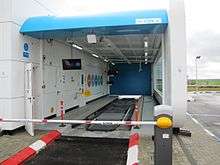
The Better Place network was the first modern commercial deployment of the battery switching model. The Renault Fluence Z.E. was the first electric car enabled with switchable battery technology available for the Better Place network in operation in Israel and Denmark.[65] Better Place launched its first battery-swapping station in Israel, in Kiryat Ekron, near Rehovot in March 2011. The battery exchange process took five minutes.[59][66] Better Place filed for bankruptcy in Israel in May 2013.[67][68] Under Better Place's business model, the company owned the batteries, so the court liquidator had to decide what to do with customers who did not have ownership of the battery and risked being left with a useless car.[69]
Tesla designed its Model S to allow fast battery swapping.[51] In June 2013, Tesla announced its goal of deploying a battery swapping station in each of its supercharging stations. At a demonstration event in 2013, Tesla showed that a battery swap operation with the Model S took just over 90 seconds, about half the time it takes to refill a gasoline-powered car used for comparison purposes during the event.[60][70] The first stations were planned to be deployed along Interstate 5 in California because, according to Tesla, a large number of Model S sedans make the San Francisco-Los Angeles trip regularly. Those stations were to be followed by ones on the Washington, DC, to Boston corridor. Elon Musk said the service would be offered for the price of about 15 US gallons (57 l; 12 imp gal) of gasoline at the current local rate, around US$60 to US$80 at June 2013 prices. Owners could pick up their battery pack fully charged on the return trip, which was included in the swap fee. Tesla would also offer the option to keep the pack received on the swap and pay the price difference if the battery received was newer, or to receive the original pack back from Tesla for a transport fee. Pricing had not been determined.[60] In June 2015, Musk indicated that Tesla was likely to abandon its plans to build a network of swap stations. He told his company's shareholders that, despite inviting all Model S owners in the California area to try out the one existing facility, at Harris Ranch, only four or five people had done so. Consequently, it was unlikely that the concept was worth expanding.[71]

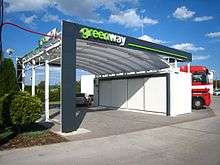

Other battery swapping service providers include Gogoro, Delta Electronics, BattSwap, and Voltia.[72][73] NIO has 131 swap stations in China.[74]
Criticism
These battery swapping solution have been criticized for being proprietary. By creating a monopoly regarding the ownership of the batteries and the patent protected technologies the companies split up the market and decrease the chances of a wider usage of battery swapping.[75]
Charging station manufacturers
The principal suppliers and manufacturers of charging stations offer a range of options from simple charging posts for roadside use, charging cabinets for covered parking places to fully automated charging stations integrated with power distribution equipment[76]
An operator manages charging stations from one or more manufacturers.
Block heater power supplies
In colder areas such as Finland, some northern US states and Canada there already exists some infrastructure for public power outlets provided primarily for use by block heaters and set with circuit breakers that prevent large current draws for other uses. These can sometimes be used to recharge electric vehicles, albeit slowly.[77] In public lots, some such outlets are turned on only when the temperature falls below −20 °C, further limiting their use.[78]
Standards
Voltage and power
The US-based SAE International defines Level 1 charging as using a standard 120 volt AC house outlet to charge an electric vehicle. This will take a long time to fully charge the car but if only used to commute or travel short distances, a full charge is not needed or can be done overnight.[79] Level 1 is not used in countries where houses typically have 200-240 V.
240 volt AC charging is known as Level 2 charging. In North and South America, 240 V is used for household appliances such as clothes driers but in many countries it is the default for most households. Level 2 chargers range from chargers installed in consumer garages, to relatively slow public chargers. They can charge an electric car battery in 4–10 hours.[80] Level 2 chargers are often placed at destinations so that drivers can charge their car while at work or shopping. Level 2 charge points are standard in many countries outside of North and South America. In North and South America Level 2 home chargers are best for drivers who use their vehicles more often or require more flexibility.
"AC Level 3" charging was defined in early editions of SAE J1772 at up to 400 amps, but has been dropped. Edition 7 of J1772 (2017) states in Appendix M "AC Level 3 charging has never been implemented. The following is historical information for reference only." The term "Level 3" appears to have been adopted colloquially to mean DC "fast" charging, although "Level 3" was never defined to mean that in J1772. Table 17 in Appendix M of J1772 (2017) lists AC Level 2 and AC Level 3 from 208 to 240 VAC, and DC Charging with 208-600 V input and 0–1000 V DC output. A Level 3 charging station may cost $120,000.[81]
DC charging generally supports charging up to 500 volts for passenger cars. Some newer high-end passenger car EVs and many heavy duty EV trucks and buses use DC charging with a nominal DC voltage of 700 V or higher, but below 1000 V peak. The organization CHAdeMO was the world's first standardized fast charging protocol with mass-produced EVs in the market.[82] DC chargers in North America often use a 480 VAC input delivering 62.5 kW (peak power can be as much as 120 kW and is varied across the charge. 208 VAC inputs to the charger are also used, and 400 VAC is standard in Europe. The Tesla Supercharger is the most ubiquitous in the United States. For a Tesla Model S75, a supercharger can add around 275 km (170 miles) of range in about 30 minutes or a full charge in around 75 minutes.[79] As of April 2018, Tesla reports that they have 1,210 supercharging stations and is continuously expanding the network.[83]
Another standards organization, The International Electrotechnical Commission, defines charging in modes (IEC 62196).
- Mode 1 – slow charging from a regular electrical socket (single- or three-phase)
- Mode 2 – slow charging from a regular socket but with some EV specific protection arrangement (e.g., the Park & Charge or the PARVE systems)
- Mode 3 – slow or fast charging using a specific EV multi-pin socket with control and protection functions (e.g., SAE J1772 and IEC 62196)
- Mode 4 – fast charging using some special charger technology such as CHAdeMO
There are three connection cases:
- Case A is any charger connected to the mains (the mains supply cable is usually attached to the charger) usually associated with modes 1 or 2.
- Case B is an on-board vehicle charger with a mains supply cable which can be detached from both the supply and the vehicle – usually mode 3.
- Case C is a dedicated charging station with DC supply to the vehicle. The mains supply cable may be permanently attached to the charge-station such as in mode 4.
Plugs
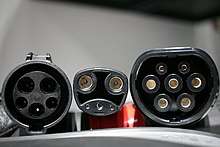
There are four plug types:
- Type 1 – single-phase vehicle coupler – reflecting the SAE J1772/2009 automotive plug specifications
- Type 2 – single- and three-phase vehicle coupler – reflecting the VDE-AR-E 2623-2-2 plug specifications
- Type 3 – single- and three-phase vehicle coupler equipped with safety shutters – reflecting the EV Plug Alliance proposal
- Type 4 – fast charge coupler – for special systems such as CHAdeMO
For Combined Charging System (CCS) DC charging which requires PLC (Powerline Communications), two extra connectors are added at the bottom of Type 1 or Type 2 vehicle inlets and charging plugs to connect high voltage DC charging stations to the battery of the vehicle. These are commonly known as Combo 1 or Combo 2 connectors. The choice of Combo 1 or Combo 2 style inlets is normally standardised on a per-country basis, so that public charging providers do not need to fit cables with both variants. Generally, North America uses Combo 1 style vehicle inlets, most of the rest of the world uses Combo 2 style vehicle inlets for CCS.
Reports emerged in late July 2013 of a significant conflict between the companies responsible for the two types of charging plugs. The Japanese-developed CHAdeMO standard is favored by Nissan, Mitsubishi, and Toyota, while the SAE J1772 Combo standard is backed by GM, Ford, Volkswagen, and BMW. Both are direct-current quick-charging systems designed to charge the battery of an electric vehicle to 80 percent in approximately 20 minutes, but the two systems are completely incompatible. In light of an ongoing feud between the two groups, experts in the field warned that the momentum of the electric vehicle market will be severely affected.[84][85] Richard Martin, editorial director for clean technology marketing and consultant firm Navigant Research, stated:
Fast charging, however and whenever it gets built out, is going to be key for the development of a mainstream market for plug-in electric vehicles. The broader conflict between the CHAdeMO and SAE Combo connectors, we see that as a hindrance to the market over the next several years that needs to be worked out.[85]
EV charging station signs

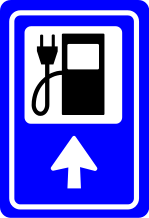
In the United States, the standard charging station sign is defined in the Federal Highway Administration's Manual on Uniform Traffic Control Devices (MUTCD) 2009 edition.[86]
In July 2013, FHWA released interim MUTCD approval for charging station signs located on public roads governed by MUTCD standards.[87]
There is an open source, public domain European charge station sign proposed.[88]
Related technologies
Smart grid communication
Recharging a large battery pack presents a high load on the electrical grid, but this can be scheduled for periods of reduced load or reduced electricity costs. In order to schedule the recharging, either the charging station or the vehicle can communicate with the smart grid. Some plug-in vehicles allow the vehicle operator to control recharging through a web interface or smartphone app.[89] Furthermore, in a vehicle-to-grid scenario the vehicle battery can supply energy to the grid at periods of peak demand. This requires additional communication between the grid, charging station, and vehicle electronics. SAE International is developing a range of standards for energy transfer to and from the grid including SAE J2847/1 "Communication between Plug-in Vehicles and the Utility Grid".[90][91] ISO and IEC are also developing a similar series of standards known as ISO/IEC 15118: "Road vehicles -- Vehicle to grid communication interface".
Renewable electricity and RE charging stations
Charging stations are usually connected to the electrical grid, which often means that their electricity originates from fossil-fuel power stations or nuclear power plants. Solar power is also suitable for electric vehicles. Nidec Industrial Solutions has designed a system that can be powered by either the grid or renewable energy sources like PV (50-320 kW). SolarCity is marketing its solar energy systems along with electric car charging installations. The company has announced a partnership with Rabobank to make electric car charging available for free to owners of Tesla vehicles traveling on Highway 101 between San Francisco and Los Angeles. Other cars that can make use of same charging technology are welcome.[92]
SPARC station
The SPARC (Solar Powered Automotive ReCharging Station) uses a single custom fabricated monocrystalline solar panel capable of producing 2.7 kW of peak power to charge pure electric or plug-in hybrid to 80% capacity without drawing electricity from the local grid. Plans for the SPARC include a non-grid tied system as well as redundancy for tying to the grid through a renewable power plan.
E-Move charging station
The E-Move Charging Station is equipped with eight monocrystalline solar panels, which can supply 1.76 kWp of solar power. With further refinements, the designers are hoping to generate about 2000 kWh of electricity from the panels over the year.[93]
Wind-powered charging station
In 2012, Urban Green Energy introduced the world's first wind-powered electric vehicle charging station, the Sanya SkyPump. The design features a 4 kW vertical-axis wind turbine paired with a GE WattStation.[94]
See also
- Automated charging machine
- Direct coupling
- ECOtality
- Electric vehicle battery
- Electric vehicle network
- Inductive charging
- GridPoint
- Filling station
- IAV
- List of energy storage projects
- Magne Charge
- OpenEVSE
- Pantographs and underbody collectors
- Park & Charge
- Plugless Power
- Radio-frequency identification RFID
- Solar Roadways
- Solar vehicle
- Street light
Notes
- Reardon, William A. (1973). The energy and resource conservation aspects of electric vehicle utilization for the City of Seattle. Richland, WA: Battelle Pacific Northwest Laboratories. pp. 28–29.
- "Charging at Home". Energy.gov. Retrieved 3 October 2019.
- Stenquist, Paul (11 July 2019). "Electric Chargers for the Home Garage". The New York Times. Retrieved 3 October 2019.
- Savard, Jim (16 August 2018). "Is it Time to Add Electric Vehicle Charging Stations to Your Retail Shopping Center?". Metro Commercial. Retrieved 3 October 2019.
- "Alternative Fuels Data Center: Workplace Charging for Plug-In Electric Vehicles". afdc.energy.gov. Retrieved 3 October 2019.
- Siddiqui, Faiz (14 September 2015). "There are now more places to charge your electric vehicle in Maryland — for free". The Washington Post. Retrieved 3 October 2019.
- "A Simple Guide to DC Fast Charging". Fleetcarma.com. Archived from the original on 2017-12-26. Retrieved 2017-10-05.
- "Guide to buy the right EV home charging station". US: Home Charging Stations. 2018-01-03. Retrieved 2018-09-01.
- "Supercharger | Tesla". www.tesla.com. Retrieved 2017-11-28.
- "Supercharging". www.tesla.com. Retrieved 2017-11-28.
- "Electric Vehicle Charging". Blink CarCharging. Retrieved 2017-11-28.
- "Driver FAQ". ChargePoint. Retrieved 2017-11-29.
- "Honda Fit EV". PluginCars.com. Retrieved 16 July 2015.
- "Don't Blink… – A Perfect Fit". A Perfect Fit. Retrieved 16 July 2015.
- King, Danny. "Ecotality trying to fix charging station problems by reducing power". Autoblog. Retrieved 16 July 2015.
- "Electric Vehicle Charging Levels, Modes and Types Explained | North America Vs. Europe Charging cables and plug types". Retrieved 2020-02-11.
- https://insideevs.com/news/372749/charin-hpccv-over-2-mw-power/
- "Plug-In 2008: Company News: GM/V2Green/Coulomb/Google/HEVT/PlugInSupply". CalCars. 2008-07-28. Retrieved 2010-05-30.
- Source: US Department of Transportation, Bureau of Transportation Statistics, Omnibus Household Survey. Data from the February, April, June, and August 2003 surveys have been combined. Data cover activities for the month prior to the survey. (October 2003). "From Home to Work, the Average Commute is 26.4 Minutes" (PDF). OmniStats. 3 (4). Archived from the original (PDF) on 2009-05-12. Retrieved 2009-10-15.CS1 maint: multiple names: authors list (link)
- International Energy Agency, Clean Energy Ministerial, and Electric Vehicles Initiative (April 2013). "Global EV Outlook 2013 – Understanding the Electric Vehicle Landscape to 2020" (PDF). International Energy Agency. Archived from the original (PDF) on 2013-04-23. Retrieved 2013-04-20.CS1 maint: multiple names: authors list (link) See pp. 14-15.
- "CHAdeMO Association". Retrieved 16 July 2015.
- Palin, Adam (2013-11-19). "Infrastructure: Shortage of electric points puts the brake on sales". Financial Times. Retrieved 2013-12-28.
- KredEx (2013-02-20). "Estonia becomes the first in the world to open a nationwide electric vehicle fast-charging network". Estonian World. Retrieved 2013-12-28.
- Vaughan, Adam (2013-02-20). "Estonia launches national electric car charging network". The Guardian. Retrieved 2013-12-28.
- "Utilities, states work together to expand EV charging infrastructure". Daily Energy Insider. 2018-08-13. Retrieved 2018-08-30.
- United States Department of Energy (2013-04-09). "Alternative Fueling Station Counts by State". Alternative Fuels Data Center (AFDC). Retrieved 2013-04-10. The AFDC counts electric charging units or points, or EVSE, as one for each outlet available, and does not include residential electric charging infrastructure.
- King, Danny (2013-04-10). "US public charging stations increase by 9% in first quarter". Autoblog Green. Retrieved 2013-04-10.
- Renault (2012-12-17). "Renault delivers first ZOE EV" (Press release). Green Car Congress. Retrieved 2012-12-17.
- "Ladepunkter i Norge" [Charge Points in Norway] (in Norwegian). Grønn bil. Archived from the original on 2012-04-26. Retrieved 2013-04-10.
- Toor, Amar (10 July 2013). "Every Dutch citizen will live within 31 miles of an electric vehicle charging station by 2015". The Verge. Vox Media. Retrieved 11 July 2013.
- Stichting E-laad (21 January 2014). "Ondersteuning laadinfrastructuur elektrische auto's wordt voortgezet". Retrieved 26 May 2014.
- Bräunl, Thomas (2013-09-16). "Setting the standard: Australia must choose an electric car charging norm". The Conversation Australia. Retrieved 2013-09-16.
- El ámbito (25 April 2017). "Repsol back on track on YPF road: now for electric cars". Retrieved 27 April 2017.
- Halvorson, Bengt (2019-08-20). "Green Car Reports". Green Car Reports. Retrieved 2019-09-12.
- Shahan, Zachary (22 July 2017). "Tesla Superchargers vs … Ugh". CleanTechnica. Retrieved 23 July 2017.
needs to be done to make a charging network or just individual charging stations adequate for EV drivers .. plenty of complaints about such inaccessible charging stations .. it can take what seems like ages to actually find the station because of how invisible it is .. some charging stations are down 50% of the time .. Unless you’re willing to increase your travel time by ≈50%, charging at 50 kW on a road trip doesn’t really cut it ..
- "Want electric vehicles to scale? Add chargers to gas stations".
- Asensio, Omar Isaac; Alvarez, Kevin; Dror, Arielle; Wenzel, Emerson; Hollauer, Catharina; Ha, Sooji (June 2020). "Real-time data from mobile platforms to evaluate sustainable transportation infrastructure". Nature Sustainability. 3 (6): 463–471. doi:10.1038/s41893-020-0533-6. ISSN 2398-9629.
- "EVPlug Alliance". Archived from the original on 1 August 2015. Retrieved 16 July 2015.
- "MENNEKES – Plugs for the world: The solution for Europe: type 2 charging sockets with or without shutter". Archived from the original on 16 July 2015. Retrieved 16 July 2015.
- IEC 62196-1
- IEC 61851-1
- "Industrial electrical vehicle stalwarts head out on the road". Archived from the original on 2011-07-16. Retrieved 2010-10-24.
- "Trucking's Eclipsed Electric Age". The Lost Annals of Transport. William B. Cassidy. Retrieved 2015-10-26.
- Kirsch, David A. (2000). The Electric Vehicle and the Burden of History. Rutgers University Press. pp. 153–162. ISBN 0-8135-2809-7.
- "BIT Attends the Delivery Ceremony of the 2008 Olympic Games -Alternative Fuel Vehicles". Beijing Institute of Technology. 2008-07-18. Retrieved 2013-06-02.
- "TECHNOLOGY : Something New Under the Hawaiian Sun: a Solar Car : Japan will import up to 2,000 SunRay zero-emission vehicles. Assembly will take place at a former sugar plantation town".
- {{cite web|title=Budd Steinhilbur, FIDSA |url=https://www.idsa.org/members/budd-steinhilber-fidsa
- {{cite web|title=Isle-designed electric scooters win $300,000 grant.|url=http://archives.starbulletin.com/98/04/10/features/index.html
- {{cite web|title=Both Sides Now, New show lets Simi Valley's Todd Bank exercise his left and right brain.|url=http://archive.vcstar.com/news/both-sides-now-ep-375301185-352839091.html/?page=1
- {{cite web|title=The Tour De Sol Reports, 2004.|url=http://www.autoauditorium.com/TdS_Reports_2004/
- Blanco, Sebastian (2009-09-27). "REPORT: Tesla Model S was designed with battery swaps in mind". Autoblog Green. Retrieved 2013-06-22.
- "Mitsubishi working on battery swapping for transit buses, Better Place not involved".
- "Better Place. Battery switch stations". Archived from the original on 2012-08-14.
- Siler, Steve (2013-06-21). "Tesla launches battery-swapping service for two-minute recharging". Yahoo Autos. Retrieved 2013-06-23.
- Green, Catherine (2013-06-21). "Tesla shows off its battery-swapping station: 90 seconds and less than $100". Silicon Valley Mercury News. Retrieved 2013-06-23.
- "Tesla shuts down battery swap program in favor of Superchargers, for now". www.teslarati.com. Retrieved 2018-04-18.
- "Supercharger | Tesla". www.tesla.com. Retrieved 2018-04-18.
- "Supercharger | Tesla". www.tesla.com. Retrieved 2020-07-09.
- Udasin, Sharon (24 March 2011). "Better Place launches 1st Israeli battery-switching station". The Jerusalem Post. Retrieved 2011-03-25.
- Rogowsky, Mark (2013-06-21). "Tesla 90-Second Battery Swap Tech Coming This Year". Forbes. Retrieved 2013-06-22.
- "Better Place, California Battery Switch Station Deployment". Archived from the original on 2010-12-05.
- "Better Place, battery switch station description". Archived from the original on 2012-08-14.
- "Lithium Ion Israel".
- "Better Place's Renault Fluence EV to sell for under $20,000".
- "Better Place. The Renault Fluence ZE". Better Place. 2010-10-22. Archived from the original on 2010-09-12. Retrieved 2010-10-22.
- Motavalli, Jim (2011-07-29). "Plug-and-Play Batteries: Trying Out a Quick-Swap Station for E.V.'s". The New York Times. Retrieved 2013-06-23.
- Kershner, Isabel (2013-05-26). "Israeli Venture Meant to Serve Electric Cars Is Ending Its Run". The New York Times. Retrieved 2013-05-27.
- Elis, Niv (2013-05-26). "Death of Better Place: Electric car co. to dissolve". The Jerusalem Post. Retrieved 2013-05-30.
- Ben-Gedalyahu, Dubi (2013-05-26). "Better Place CEO: A missed opportunity". Globes. Archived from the original on 2013-06-09. Retrieved 2013-05-28.
- "Tesla Motors demonstrates battery swap in the Model S". Green Car Congress. 2013-06-21. Retrieved 2013-06-22.
- Sorokanich, Robert (2015-06-10). "Musk: Tesla "unlikely" to pursue battery swapping stations". Road & Track. Retrieved 2015-10-26.
- Voltia Group (2015-12-02), Companies successfully using the GreenWay Service, retrieved 2017-04-25
- "Electric-Car Battery Swapping, Slovakian Style (Well, Vans, Anyway)". Green Car Reports. Retrieved 2017-04-25.
- Hanley, Steve (31 May 2020). "NIO Completes More Than 500,000 Battery Swaps". CleanTechnica.
- "Tesla battery swap a dead end". 2013-06-21. Retrieved 2014-02-12.
- "Electric vehicles – About electric vehicles – Charging – suppliers". london.gov.uk. 2009. Archived from the original on 2012-04-05. Retrieved 2011-11-24.
- Electric Vehicles, Manitoba Hydro, retrieved 2013-04-02,
Manitobans' experience with cold weather and plugging in their vehicles will help ease the transition to adopting PEVs. In some circumstances, the existing infrastructure used to power vehicle block heaters in the winter can also be used to provide limited charging for PEVs. However, some existing electrical outlets may not be suitable for PEV charging. Residential outlets can be part of a circuit used to power multiple lights and other electrical devices, and could become overloaded if used to charge a PEV. A dedicated circuit for PEV charging may need to be installed by a licensed electrician in these situations. Also, some commercial parking lot outlets operate in a load restricted or cycled manner and using them may result in your PEV receiving a lower charge than expected or no charge at all. If a parking stall is not specifically designated for PEV use, we recommend that you consult with the parking lot or building manager to ensure it can provide adequate power to your vehicle.
- Park and Ride Locations, Calgary Transit, 2009-04-16, retrieved 2009-04-25,
The plug-ins located in the Park and Ride lots automatically turn on when the outside temperature falls below −20 degrees and turn off and on in increments to save electricity usage.
- "Understanding Electric Vehicle Charging – Plug In America". Plug In America. 2011-01-31. Retrieved 2017-11-29.
- Administrator. "Levels of Charging – EVTown". www.evtown.org. Retrieved 2017-11-29.
- "Regular Council Meeting Minutes, December 3, 2019". Municipality of Jasper. 17 December 2019. p. 45.
The estimated capital cost is approximately $60,000for charger and related equipment costs, and $60,000for engineering/design/installation costs, for a total estimated cost of $120,000
- "What is Fast Charging – Chademo Association". chademo.com. Retrieved 2017-11-29.
- "Supercharger". tesla.com. Retrieved 2017-11-29.
- Upton, John (2013-07-26). "EV market threatened by spat over charger standards". Grist.org. Retrieved 2013-07-29.
- Pyper, Juliet (2013-07-24). "Charger standards fight confuses electric vehicle buyers, puts car company investments at risk". ClimateWire. E&E Publishing, LL. Retrieved 2013-07-29.
- "MUTCD 2009 Edition, Original, dated December 2009 (PDF) – FHWA MUTCD". mutcd.fhwa.dot.gov. Retrieved 2015-06-02. - See two examples of "D9-11b Electric Vehicle Charging" and "D9-11bP Electric Vehicle Charging" at "Figure 2I-1. General Service Signs and Plaques", page 301, Sect. 2I.02
- "MUTCD – Regulatory Signs for Electric Vehicle Charging and Parking Facilities Memorandum – FHWA MUTCD". mutcd.fhwa.dot.gov. Retrieved 2015-06-02.
- ニキビが出来やすいクセ、食べ物紹介ブログ (in Japanese). Archived from the original on 2015-07-16. Retrieved 2015-07-16.
- "Tesla Motors Introduces Mobile App for Model S Sedan". 2013-02-06.
- "SAE Ground Vehicle Standards Status of work – PHEV +" (PDF). SAE International. January 2010. pp. 1–7. Archived from the original (PDF) on 2012-09-29. Retrieved 2010-09-03.
- https://www.sae.org/standards/content/j2931/1/
- "SolarCity Installs Electric Car Chargers Along Cal Highway". Retrieved 16 July 2015.
- "Archived copy". Archived from the original on 2013-11-30. Retrieved 2012-04-07.CS1 maint: archived copy as title (link)
- "Sanya Skypump: World's first wind-fueled EV charging station – Digital Trends". Digital Trends. 14 August 2012. Retrieved 16 July 2015.
| Wikimedia Commons has media related to Electric vehicle charging stations. |
